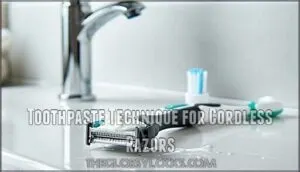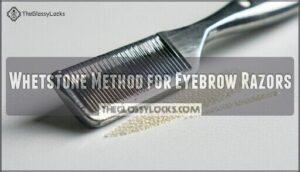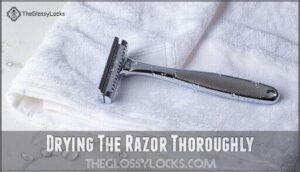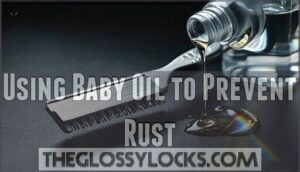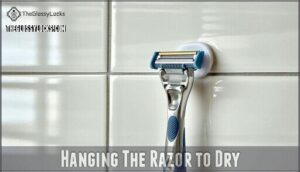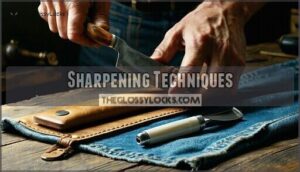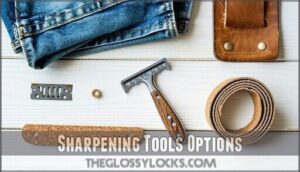This site is supported by our readers. We may earn a commission, at no cost to you, if you purchase through links.
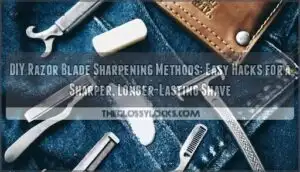
The denim technique works well – run your clean, dry razor backward along old jeans 15-20 times.
This realigns the blade edge without removing metal.
For straight razors, use a leather strop with gentle, consistent strokes.
The toothpaste method involves rubbing a small amount on the blade, then rinsing thoroughly.
Whetstone sharpening offers precision for single-edge blades.
Always clean and dry your razor before sharpening, and store it properly afterward.
These techniques can extend blade life substantially, saving money while maintaining performance across different razor types.
Table Of Contents
- Key Takeaways
- Razor Blade Sharpening Basics
- DIY Sharpening Methods
- Razor Blade Care Tips
- Sharpening Techniques
- Sharpening Tools Options
- Frequently Asked Questions (FAQs)
- Does baby oil keep razor blades sharp?
- What can I use to sharpen a razor blade?
- How to make a dull razor sharp again?
- How to sharpen a straight razor at home?
- How to sharpen a single edge razor blade?
- Can I sharpen razor blades with a diamond stone?
- How often should I sharpen my razor blades for optimal use?
- Will sharpening my razor blades void the manufacturers warranty?
- Can I use a sharpening steel to hone razor blades?
- Are there any safety precautions I should take when sharpening razors?
- Conclusion
Key Takeaways
- You can extend your razor blade’s lifespan 2-3 times longer using simple household items like denim, leather strops, toothpaste, or whetstones – no expensive equipment needed.
- The denim method works best for most razors: run your clean, dry blade backward along old jeans 15-20 times to realign the edge without removing metal.
- Proper blade care matters more than sharpening – always dry your razor thoroughly after use, store it in a moisture-free place, and consider using baby oil to prevent rust.
- Different razor types need specific techniques: straight razors work best with leather strops, disposables respond well to denim, and whetstones offer precision for single-edge blades.
Razor Blade Sharpening Basics
You’ll want to keep your razor blades sharp to avoid nicks, cuts, and irritation that come with dull edges.
Several factors affect how long your blades stay sharp, including hair thickness, shaving frequency, and how you store your razor between uses.
Importance of Sharp Razor Blades
Sharp razor blades deliver the close shave you want while minimizing skin irritation and safety concerns.
When your blade maintains peak cutting efficiency, you’ll need fewer passes across your skin, reducing nicks and razor burn.
A sharp blade also extends blade lifespan through proper razor blade sharpening techniques, saving money while improving your daily routine.
Factors Affecting Blade Life
Several key factors determine how long your razor blades stay sharp.
Blade material matters most – stainless steel lasts longer than carbon steel. Usage frequency directly impacts longevity; daily shavers need razor blade sharpening more often.
Shaving cream quality affects blade wear, while water hardness creates mineral buildup. Storage conditions play a vital role in razor blade maintenance.
Proper care can extend razor life substantially through effective razor sharpening methods. **Proper drying techniques are also essential to prevent rust.
Choosing The Right Sharpening Tool
You’ll want to match your DIY razor sharpen technique with the right sharpening tool for best results.
Different razor types need specific approaches, so consider these factors:
- Tool Material – Leather strops work great for straight razors, while denim suits disposables
- Grit Selection – Whetstones offer various grits; start coarse, finish fine for eyebrow razors
- Handle Ergonomics – Choose tools that feel comfortable during extended razor sharpening methods
- Tool Size – Compact razor blade sharpener options work better for travel and storage
- Budget Considerations – Simple household items like toothpaste can sharpen razor blades effectively
For ideal sharpening, consider using a razor sharpening stone.
DIY Sharpening Methods
You can sharpen razor blades at home using simple household items that work surprisingly well. These DIY methods help extend blade life and maintain cutting performance without expensive equipment.
Toothpaste Technique for Cordless Razors
Your cordless razor can get a second life with toothpaste’s mild abrasiveness. Apply a pea-sized amount to clean blades, run for 30-60 seconds, then rinse thoroughly.
This technique works on both rotary and foil cordless razor types through gentle honing action. Toothpaste acts as a budget-friendly sharpening method due to its abrasive properties.
For stubborn buildup, try alternative pastes with baking soda. Always clean post-sharpening to prevent residue damage, ensuring your razor remains in good condition after using this budget-friendly method.
Denim Method for Straight Razors
Grab clean denim and lay it flat on a stable surface.
Hold your straight razor at a 30-degree sharpening angle, running the blade spine-first with gentle pressure control.
Complete 15-30 stroke count passes, alternating directions for even honing razor blade results.
This blade sharpening tips method extends denim lifespan while maintaining your razor’s edge between professional sharpenings.
Some users debate the effectiveness of denim fabric stropping, considering it a complete concepts approach for denim fabric and straight razor maintenance.
Strop Method for Straight Razors
Master strop technique transforms your straight razor’s performance through proper blade alignment.
Use quality strop material—leather works best for honing razor blade effectiveness.
Pull the razor flat along the strop with spine contact, maintaining consistent razor angle.
Perform 30-50 gentle passes before each shave for ideal razor edge alignment.
Regular strop maintenance with leather balm prevents cracking.
This honing frequency keeps your blade sharp between professional sharpenings, making strop razor blade care essential for every wet shaver seeking blade sharpening tips.
Whetstone Method for Eyebrow Razors
Eyebrow razors require delicate handling with whetstones. Select 1,000-8,000 whetstone grit for ideal results. Soak your stone until bubbling stops, then apply whetstone lubrication. Hold the razor at 15-20 degrees for proper angle precision. Use gentle pressure control to avoid damaging the thin edge.
A vital step involves understanding stropping realignment methods for maintaining sharpness.
Here’s your step-by-step process:
- Prepare the whetstone – Soak until saturated and level the surface for razor edge alignment
- Set your angle – Let the razor spine guide you to maintain consistent honing razor blade position
- Apply light strokes – Move from base to tip using circular motions to improve razor sharpness
- Watch for burr formation – This signals when to flip sides and progress to finer grits
- Focus on burr removal – Finish with lighter passes to sharpen dull razor effectively through proper razor blade care
Razor Blade Care Tips
You can’t sharpen a dull razor blade forever, but proper care substantially extends its lifespan and maintains peak performance.
These simple maintenance habits prevent premature dulling and keep your blade cutting cleanly for weeks longer than neglected razors, which is a result of complete concepts being applied to razor maintenance.
Drying The Razor Thoroughly
Water is your razor’s enemy in terms of rust prevention.
Keep your razor dry after every shave—moisture kills sharp edges fast.
After each shave, rinse your blade thoroughly and shake off excess water. Pat the razor dry with a clean towel, focusing on blade edges and crevices where moisture hides.
| Drying Method | Effectiveness |
|---|---|
| Air drying | Good for basic maintenance |
| Towel patting | Removes stubborn water droplets |
| Hair dryer (cool) | Reaches tight spaces completely |
Proper drying methods extend blade longevity substantially, preventing corrosion that dulls your razor blade care routine.
Storing The Razor in a Dry Place
After thorough drying, store your razor in a moisture-free environment to maximize blade longevity.
Choose a well-ventilated bathroom cabinet or bedroom drawer over humid shower areas.
Proper ventilation prevents rust formation, which is your biggest enemy when you sharpen disposable razor blades at home.
This simple razor sharpening hack costs nothing but adds weeks to your blade’s life, making any homemade razor sharpener technique more effective, and is a great way to get the most out of your razor, with proper ventilation.
Using Baby Oil to Prevent Rust
A few drops of baby oil create a protective barrier that locks moisture out and keeps your razor blade rust-free.
Apply the oil directly to clean, dry blades after each use, focusing on the cutting edges.
This razor sharpening hack forms a thin film that prevents oxidation, substantially extending razor blade longevity.
The oil’s molecular structure repels water better than other household oils, making it ideal for homemade razor sharpener maintenance routines.
Hanging The Razor to Dry
After each shave, hang your razor in a well-ventilated storage environment to maximize air drying and rust prevention.
Position the blade at a favorable angle using simple hanging materials like hooks or clips.
This DIY blade sharpener approach helps prolong blade life by preventing moisture buildup.
Proper airflow around the blade creates ideal conditions for your sharpen razor at home routine, making this one of the most budget-friendly ideas for razor maintenance.
Sharpening Techniques
Different razor types need specific sharpening approaches to restore their cutting edge effectively.
You’ll find that single-edge razors respond well to stropping, while multi-edge cartridges benefit from gentle denim polishing techniques to maintain their edge.
Sharpening Single-Edge Razors
For single-edge razors, you’ll master sharpening by laying the blade flat on a whetstone. Let the spine set your angle automatically—this guarantees proper Angle Consistency without guesswork.
Apply gentle Pressure Control as you make edge-leading strokes. Start with 1,000 grit stones for dull blades, then progress to 4,000-8,000 grit for razor-sharp finishes.
Your diy blade sharpener technique focuses on Burr Removal through careful Stropping Direction. Understanding Blade Material helps determine ideal pressure.
This sharpen razor at home method will prolong blade life effectively, making it perfect for budgetfriendly ideas and DIY projects.
Sharpening Multi-Edge Razors
Multi-edge cartridges present unique challenges due to their complex cartridge razor design. Unlike single blades, these tightly-packed edges require specialized techniques that work within their constraints.
Here’s how to sharpen razor at home effectively:
- Denim stropping: Run the cartridge backward against jeans 15-20 times to realign micro-serrations
- Leather honing: Use damp vegetable-tanned leather, stroking forward 8-10 times with proper pressure and angle
- Oil storage: Store cartridges in mineral oil to prevent oxidation between uses
Cleaning multi-blades thoroughly after each use maximizes sharpening frequency effectiveness. These budget-friendly ideas extend cartridge life 2-5 times normal duration. Lubrication importance can’t be overstated—proper technique preserves factory coatings while realigning edges for smoother performance.
Sharpening Straight Razors
Straight razors demand respect and proper technique.
Hold your razor at a 30-degree angle against quality strop materials like leather or canvas.
Apply light honing pressure while maintaining perfect blade alignment.
Work the razor in smooth, deliberate strokes away from the cutting edge.
Quality sharpening compounds enhance the process, much like precision tools improve home improvement projects or car maintenance tasks.
Sharpening Eyebrow Razors
Eyebrow razors require gentle precision due to delicate facial skin.
Use a 30-degree razor angle for ideal eyebrow shaping while protecting skin sensitivity.
Quality blade material matters – stainless steel resists dulling better than cheaper alternatives.
Regular use of stropping methods detailed can also help maintain sharpness between uses.
Clean your razor after each use since eyebrow hair and oils dull blades quickly.
This simple home maintenance keeps your DIY projects effective and guarantees home safety during personal grooming routines, ensuring effective maintenance.
Sharpening Tools Options
You don’t need expensive sharpening tools to keep your razors performing like new. Several household items can effectively restore your blade’s edge and extend its life substantially.
Using Denim to Sharpen Razors
After exploring sharpening techniques, let’s talk about using denim—a classic DIY, homemade solution.
Denim grit works wonders for razor blades. Here’s how you do it:
- Lay flat, clean denim (fabric type matters).
- Hold the blade at a steady razor angle.
- Apply gentle sharpening pressure, moving the blade away from the edge.
- Repeat 10-20 times for denim longevity.
This process is a form of gentle blade polishing, which can be considered a gentle form of maintenance.
Using Leather to Sharpen Razors
Leather strops deliver razor-sharp edges through controlled pressure and proper sharpening techniques.
Choose between paddle strops or hanging leather strop types for different blade sizes. A quality strop, like a leather razor strop, can greatly improve the honing process.
Maintain consistent sharpening angle while drawing the blade away from the cutting edge. Apply light pressure—let the leather do the work.
Regular strop maintenance with leather conditioner prevents cracking. DIY leather alternatives include old belts for homemade solutions in your metalworking toolkit.
Using Whetstone to Sharpen Razors
Whetstones offer precision control for razor sharpening through careful technique.
This DIY approach requires attention to three key factors:
- Whetstone Grit Selection – Start with 400-1000 grit for dull blades, finish with 4000-8000 grit
- Angle Consistency – Maintain steady 20-30 degree angle throughout each stroke
- Pressure Control – Apply light, even pressure to avoid blade damage
For quality results, consider using a dedicated sharpening stone.
Lubrication effects improve results substantially. Burr removal completes this cost-effective solution.
Using Baby Oil to Sharpen Razors
Baby oil doesn’t actually sharpen razors but extends blade life through rust prevention and blade lubrication.
Apply a thin layer after shaving to create a protective barrier against moisture. This oil application method reduces oxidation that dulls edges prematurely.
The oil viscosity helps maintain sharpness longer between uses, which is a key factor in reduced blade replacement costs. Consider this simple addition to your DIY home improvement routine for better shaving results and improved shaving experience.
Frequently Asked Questions (FAQs)
Does baby oil keep razor blades sharp?
Oil coating your razor creates a protective barrier that prevents rust and corrosion.
You’ll find baby oil works well for storage, but it won’t actually sharpen dulled blades or restore their cutting edge.
What can I use to sharpen a razor blade?
You can sharpen razor blades using leather strops, denim fabric, ceramic mugs, whetstones, or specialized sharpening gadgets. These methods restore the blade’s edge through controlled abrasion and polishing.
How to make a dull razor sharp again?
Dull blades regain their edge through stropping on leather, denim, or ceramic surfaces. You’ll drag the blade backward at proper angles, realigning microscopic teeth that cutting dulls over time.
How to sharpen a straight razor at home?
Use a leather strop or denim fabric to hone your straight razor. Start with light, consistent strokes at proper angle. Finish with stropping compound for best results.
How to sharpen a single edge razor blade?
Like polishing a diamond in the rough, you’ll need steady hands and patience.
Stroke the blade against leather or denim at a consistent 20-degree angle, moving away from the cutting edge ten times per side.
Can I sharpen razor blades with a diamond stone?
Diamond stones work excellently for sharpening razor blades.
Their consistent grit and flat surface maintain proper blade geometry.
Start with medium grit, then progress to fine. You’ll achieve professional-level sharpness that rivals expensive sharpening services.
How often should I sharpen my razor blades for optimal use?
Sharpen your razor blades every 5-7 shaves for peak performance. Watch for tugging, nicking, or increased pressure needed during shaving—these signal it’s time to refresh that edge.
Will sharpening my razor blades void the manufacturers warranty?
Most manufacturers don’t cover razor blades under warranty since they’re consumable items. However, modifying blades could technically void any coverage that exists, so check your specific warranty terms first.
Can I use a sharpening steel to hone razor blades?
No, don’t use a sharpening steel on razor blades.
Steel rods are too coarse and will damage the delicate edge.
Instead, try leather strops, denim, or ceramic plates for gentle honing that won’t ruin your blade’s precision.
Are there any safety precautions I should take when sharpening razors?
Razor-sharp safety isn’t just smart—it’s absolutely critical! Always work in good lighting, keep fingers away from blade edges, and grip handles securely to prevent slipping accidents.
Conclusion
Mastering these DIY razor blade sharpening methods transforms your grooming routine from costly to cost-effective.
Whether you’re using denim, leather strops, toothpaste, or whetstones, each technique offers unique advantages for different razor types.
These simple approaches can double or triple your blade’s lifespan while maintaining professional-grade sharpness.
With proper care, storage, and regular maintenance, you’ll achieve consistently smooth shaves without breaking your budget.
- https://assets-global.website-files.com/675368748fb37404fd4ed486/67c54c30edc39f405966927a_22822436310.pdf
- https://www.reddit.com/r/lifehacks/comments/1ayevp9/save_and_use_toothpaste_to_easily_sharpen_your/
- https://www.youtube.com/watch?v=a3dCbOpR1XU
- https://www.pritechcare.com/blog/is-it-okay-to-sharpen-the-blade-of-an-electric-shaver/
- https://leatherworker.net/forum/topic/75481-stropping-knives-and-toolswith-toothpaste/

